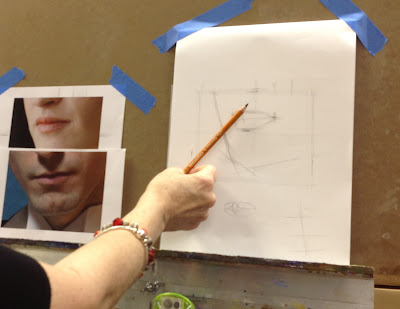This is an ongoing series that is building up to a full portrait that I'm doing with the oil painting class I teach at Forstall Art Center in Birmingham, AL. If you are joining in for the first time for this post check out Part 1, Part 2, and Part 3, to catch up.
I begin by finding the mid-point and the quarter-mark for my image to correctly locate it on the page.
I'm checking angles to block in the overall width and height of the lips.
Click Read More to see important drawing concepts below the break.
THINK ABOUT:
Non-parallelism- the concept that in organic shapes there are no such things as perfectly parallel lines.
Wedges- the concept of how organic things grow into each other, twisting and spiraling into each other. The human body is less like sticks with tubes of clay over it and more like twisting strands of rope. Muscles flow around the body, into and out of other muscle.
What is in front? - Something is always in front of something else. Have a clear image in your mind of that and it will help you see it more clearly thereby drawing a more convincing illusion.
Convexity- There are no naturally concave forms in nature. If it looks like a concavity, look again. It maybe be multiple convex curves twisting and spiraling together. There is a fullness and life to nature that plumps it up.
I think of the underlying structure of the lips. There are 3 pillows in the top lip and two in the bottom.I squint to see the larger masses of the shadow shapes.
I've been reading Anthony Ryder's, The Complete Guide to Figure Drawing: A Contemporary Perspective on the Classical Approach and Juliette Aristides, Lessons in Classical Drawing: Essential Techniques from Inside the Atelier. Both of which I highly recommend!
Next up painting the lips and mouth.






No comments:
Post a Comment